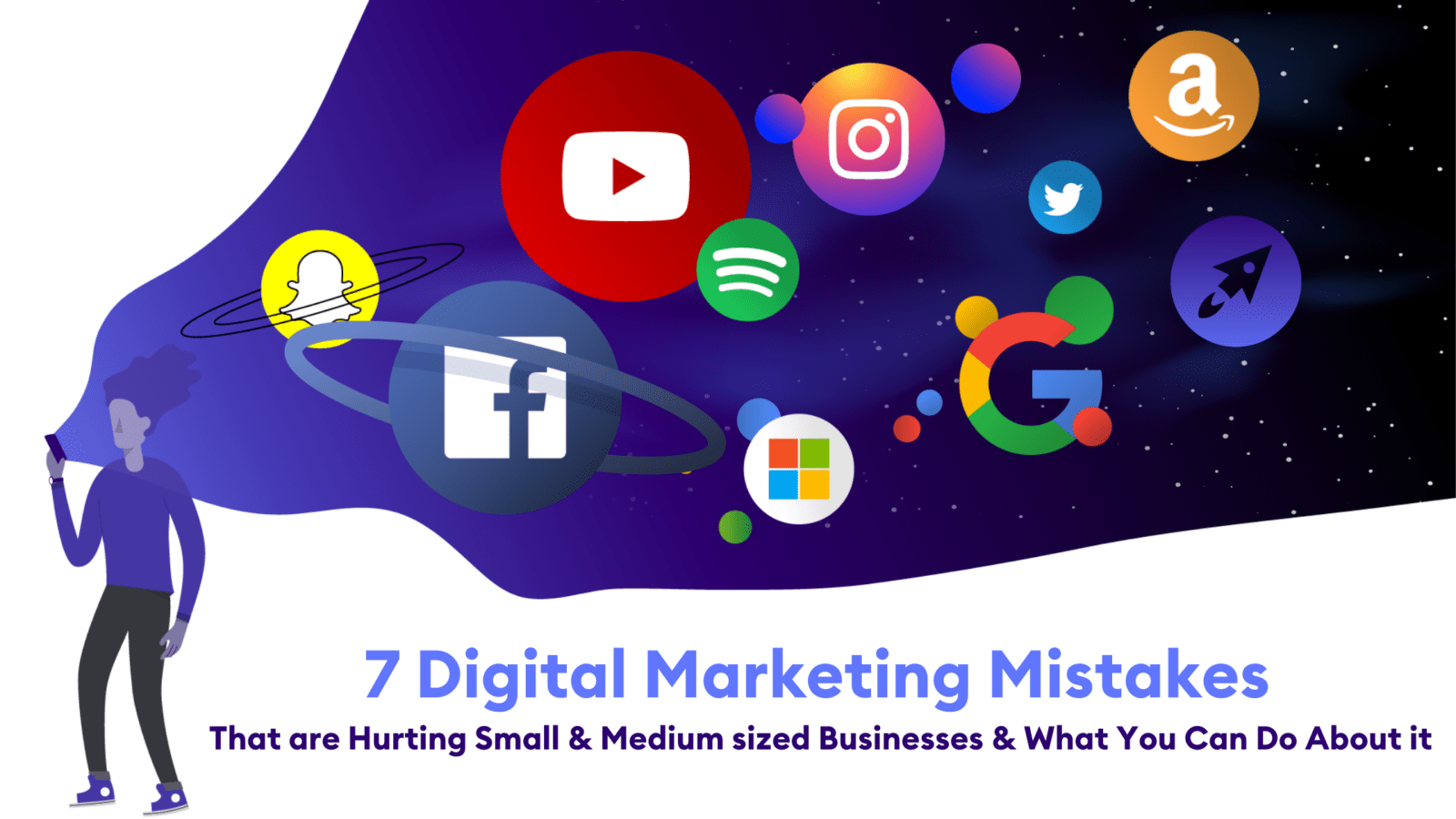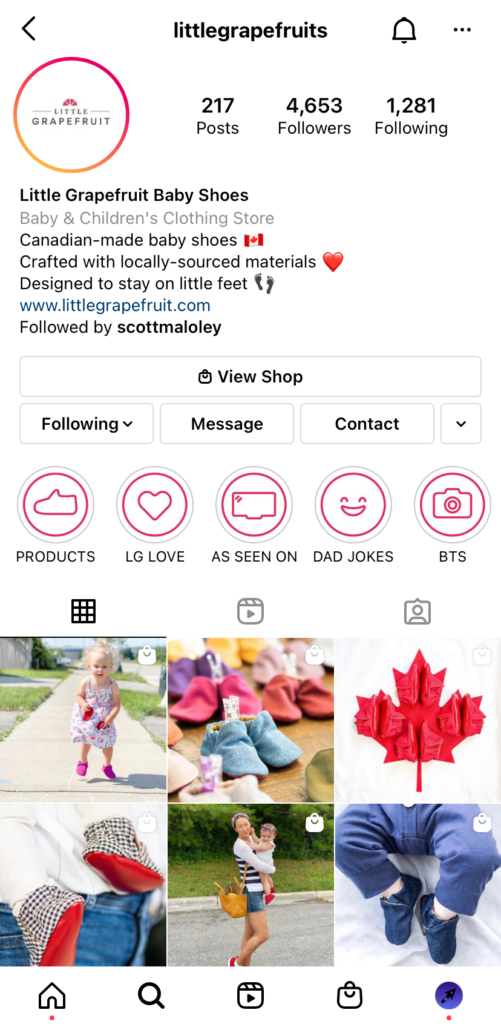7 Digital Marketing Mistakes Hurting Small & Medium sized Businesses and What You Can Do About It.
Click to Follow & Share:
[DISPLAY_ULTIMATE_SOCIAL_ICONS]When you’re running a business in the digital age, it’s easy to get caught up in all of the analytics, KPI’s, numbers and data.
How many page views does your website get? How many new leads did your website generate?
At first glance, increases in those key metrics can seem like a solid indicator of success. But what if I told you they were actually hurting your online presence?
Summary
#1: You’re Not Measuring Anything
#2: You Don’t Have a Content Strategy in Place
#3: Your Website is Lacking Mobile Support
#4: You Treat All Marketing Channels Equally
#5: Your Social Media Presence is Weak
#1: You’re Not Measuring Anything
If you want to run a successful marketing campaign, you need to know how to evaluate your progress. You can’t just assume you’re doing a good job if you’re not tracking the results of your efforts. In the world of online business, every cent invested must bring a return.
This includes; your website, your traffic, your investment — if something isn’t tracking properly, you’re losing out.
I often get questions from entrepreneurs and business owners about how to track the performance of their digital campaigns. It’s because the tools bring so much data that they are lost trying to figure out what it really means.
And so they give up, and claim that they don’t really need to measure everything, just the basics, like traffic and conversions.
However, all data tells you a story. You need to read the numbers to understand your customer journey.
It isn’t enough to just look for increases in traffic or conversions. The real secret is to dig into the data and identify patterns that will help improve your marketing over time.
You need to understand how visitors are finding you, what they do once they get there, and what the best-qualified leads look like.
In addition, you need to know your “true bounce rates“. Bounce rate is the percentage of visitors that leave a webpage without taking an action, such as clicking on a link, filling out a form, or making a purchase.
Bounce rate is significant for three reasons:
- Google includes bounce rate as a ranking element. In fact, according to an industry study, Bounce Rate is strongly linked to first-page Google rankings.
- Bounce Rate is a good indicator of whether or not your audience finds your content relevant.
- A high Bounce Rate may indicate that your websites or specific pages are not performing well. This could be an issue with content, user experience, page layout or copywriting.
For this reason, you need to understand your bounce rate and how they change on a day-by-day, week-by-week or month-by-month basis. This will give you important insights into your traffic sources and customer personas.
From there you can use that data to optimize your campaigns based on the actual performance of your website and its pages, instead of mere random impressions.
There are lots of techniques to gain this understanding. You can examine what the content consumers actually read (i.e., average time on page, etc.), or you can look at the types of devices they use to get to your site.
All these elements are critical data points in understanding the behavior of consumers and what they want out of a certain type of website. In other words, how the traffic is finding you and why it is choosing to convert with you instead of your competitors.
The truth is that digital marketing is a numbers game and you need to measure every piece of data possible if you want your business to succeed.
But, how can I easily measure my performance online?
First of all, there are dozens of tools you can use and new ones emerge every day, promising to be easier and reliable.
However, for small and medium-sized enterprises starting the online journey or seeking insights on how to hone what they already invested, it’s better to talk with the king of all data: Google.
Start with Google Analytics
Google Analytics is free and it provides a whole bunch of useful information. You will use Google Analytics for: traffic, visitor interests, conversions, demographics, etc.
For example, I have a couple of clients who are doing incredibly well in their business but they haven’t been able to figure out the email list growth.
The only thing they knew is that their last launch almost doubled the number of email subscribers on their list. All looks good, except it wasn’t.
When I asked them if they are using Google Analytics and tracking their goals properly, it turned out they weren’t.
So I showed them how to set a goal in Google Analytics for email opt-in, and then they could see how many people were actually signing up from their websites.
After that, I was able to identify the problem area: their site was designed in such a way that most visitors didn’t stay long enough to scroll down to the form.
What’s the solution? My team changed their lead capture design using A/B testing methods and saw a significant improvement, which resulted in more opt-ins.
You can also use Google Analytics for social media tracking because it will allow you to see how many of your followers are visiting your website, what content they are consuming, and if they’re buying anything.
#2: You Don’t Have a Content Strategy in Place
If you’re not using a strategy to plan and organize your content, you’re leaving it to chance.
It helps you organize your thoughts, identify your target audience, and plan the types of content you’ll create. You can’t please everyone all of the time, so you need a plan. As part of the planning and organizing process, you need a strategy.
But wait — you’re not done yet. You want to make sure these content strategies nail every ring on their choker.
What is a content strategy, then, and why do you need one?
Content marketing is where you create and distribute content online. A content strategy is what you use to coordinate all of this content with your business goals, marketing efforts, and website copy.
Content needs and objectives vary depending on brand, industry, and geography of a given audience (for example, a casual runner may have different objectives than a business owner running a fashion brand).
The objective of the content strategy needs to align with the goals of the business.
For example, small and medium-sized enterprises that don’t have a huge budget to invest online can also use a blog as a part of their overall strategy.
You can blog about the latest trends and news in your industry and what you believe will be the most relevant to your target audience.
Or share stories from within your company and across your industry (even if they’re not related to your product) – as long as they’re relevant to your blog.
But, don’t post just to appear!
You can’t just take a step back and randomly create content because you might get some traffic, that doesn’t mean it will serve your business.
One of the most common mistakes businesses make is being too focused on chasing after numbers and not enough on creating truly valuable content for their audience.
Why? Because digital marketing is about engagement.
You know, like hugs and high-fives. It’s digital marketing, relationships that lead to success.
That means your struggles will be different from others, and it means you need to create a content strategy based on those unique challenges.
#3: Your Website is Lacking Mobile Support
As you know, a lot of people access websites on mobile devices these days. If you’re not actively thinking about how your website is responding to mobile users, then you’re missing out on a big chunk of your audience.
Numbers aside, $1 spent on advertising won’t necessarily bring the right people to your website. You need to know where your best customers are getting your content and how they find your website in the first place.
If your website looks good, but your content takes seconds to load, then you’re in trouble.
But, how can I see – for FREE – if my website is mobile-friendly?
Enter your URL in a free online assessment tools like:
- Google Mobile-Friendly Test Tool – It’s a tool that allows companies to type in their URL and find out how mobile-friendly Google thinks their site is. It measures how easily users can access, read, and navigate the site on mobile devices, with a pass-fail score and suggestions for improvement.
- GTMetrix – The GTmetrix plugin is a free tool for conducting detailed website analysis. It is used by developers, digital marketers, and other digital professionals to diagnose website performance and troubleshoot it.
- SemRush – It’s a digital marketing and competitive intelligence tool that provides a range of valuable data about any site. SemRush makes you capable to track your competitor’s hideouts, their back pages which turn out as an easy-to-read and understandable backlinks list without digging deep into various data miners’ pro services.
We don’t want your marketing efforts to be in vain. That is why we always recommend that you invest time and energy into making sure your website is mobile-friendly.
#4: You Treat All Marketing Channels Equally
Don’t just spread your efforts out thinly over many different channels. Instead, put all of your effort into just a few channels that you’ve identified as being the best fit for your business.
And remember: the best channels will get the biggest Return On Investment (ROI) over the long haul. For instance, a client signed up for Facebook to promote his business, and he is already seeing results.
Instead of making quick decisions about what he could do on LinkedIn, TikTok, or Instagram, I focused on how we could grow on Facebook.
The first step was to perform an SEO audit on the client’s digital environment. Thankfully, his site was in good shape, but there were still a number of changes we needed to make — primarily related to link building and SEO (Search Engine Optimization).
The second step was to leverage the data we’d already collected in order to create a Facebook ad campaign. I used Google Analytics to uncover his top-performing posts and turned that information into lead generation ads.
On Facebook, I immediately saw a significant surge in traffic to the client’s website. In the first month, we were able to bring in five new customers, at a cost of a little more than $10 per lead.
 #6: You’re Not Engaging With Influencers or Bloggers
#6: You’re Not Engaging With Influencers or Bloggers
This is a big one. If you’re not engaging with bloggers or influential people online, they will continue to ignore you and blog about products that interest them instead.
For instance, Little Grapefruit is a local Canadian baby shoe company. Their focus is on producing comfortable, stylish, and lively shoes for little ones.
Little Grapefruit’s target market is new or expecting mothers or anyone in the market for stylish and unique high-quality baby shower gifts. They increase brand awareness in a niche market by using social media platforms such as Facebook and Instagram.
Following extensive market research and consultation with the client, I created effective Google and Facebook account structures and implemented a multi-channel eCommerce strategy that included investments in Google Shopping Ads, Google Search Ads, and Paid Social Ads on platforms such as Facebook and Instagram.
Now, Little Grapefruit is partnering with Influencers to boost their sales. With influencer marketing, there are two different options; paid partnership and unpaid exposure. One influencer Little Grapefruit is currently working with is Christine Cho (#christinechobeauty) for a paid partnership.
Christine Cho is a local Canadian Makeup and Hair artist on The Marilyn Denis Show. Her main platform is Instagram with just under 11K followers with a large reach to new mothers as she is a new mother herself! Little Grapefruit was able to reach thousands of potential new clients from a single post! When using paid partnerships Little Grapefruit is able to boost those posts through their own social media platform.
#7: You Don’t Automate Any of your Marketing Activities
There’s no better feeling than a Google Ads campaign that just explodes and gets lots of conversions, or an image from your customer using your product that generates 100+ shares.
The problem is these things are kind of unpredictable and aren’t as consistent as they should be.
Once you get into automation, you can create more consistency in your online efforts. You can design successful automation scripts that will let you publish blog articles, blog with a certain cadence, send drip emails when someone signs up for your email list and even share content on social media in the background.
By automating your marketing activities, you are adding consistency to your online efforts without sacrificing quality.
Instead of trying to create consistent outcomes from an inconsistent process, you should create a system that’s designed to produce consistent results.
You can set up automation tools so they do the work for you – this way, every blog post is blogged on time not just once or twice but consistently. You can monitor your email lists and when someone joins or leaves, send auto-replies/newsletters to your list.
Your blog posts can be shared automatically on social media with captivating images and even blog posts that are related but different from the blog post that is currently being shared.
All of these activities will lead to more subscribers, more brand exposure, and ultimately convert more leads!
Conclusion
The blog post has been written to share the most common digital marketing mistakes that are hurting your brand reputation, and what you can do about it.
You may not be aware of some of these issues or how they’re impacting your business, but by reading this blog post you should have a better understanding on where you need to focus more time in order to create an effective online presence for your company.
If any of these topics interest you please get in touch with us so we can discuss them further!
The team at Digital Clicks Marketing is always looking for a new challenge!
Let’s Talk!




 #6: You’re Not Engaging With Influencers or Bloggers
#6: You’re Not Engaging With Influencers or Bloggers



#5: Your Social Media Presence is Weak
If you have a business, you must be on social media. According to Hootsuite, 54% of the world’s population uses social media, making it a great way to interact with your customers, build trust, and engage people in conversations about your products and services.
If you’re not on social media, you’re missing out on a lot of valuable opportunities to grow your business. Have no fear, there are thousands of great tools and services available for DIY posters and the DIFM crowd.
It’s the golden rule of marketing. Just because you put something out into the world, doesn’t mean people will want to buy it.
When Seth Godin talks about how social media should work, he gives lessons that businesses need to learn. Unfortunately, many business owners believe these lessons to be profound and use them to justify their lack of social media presence.
But in reality, they’re mostly moving the goalposts to other areas of the online marketing world.
Before you post content online, ask yourself what your digital marketing objectives are. These will help you decide how best to use social media.
You want to be engaging with your audience and having conversations that are relevant to your business and your products.
CONTENT TIP: When posting content, you should add several key points to the beginning and end of your content. This practise can be used no matter the subject, anything from bodybuilders to athletes, to marketers, and more.
Overdoing it on social media could lead to getting lost in the minutia of social media and alienate your audience. Quality over quantity!
Social media was never meant to substitute the fundamental information you get on a website. Your customer journey is an ongoing process. If you want to create a successful online business, you need to also build an e-commerce presence.